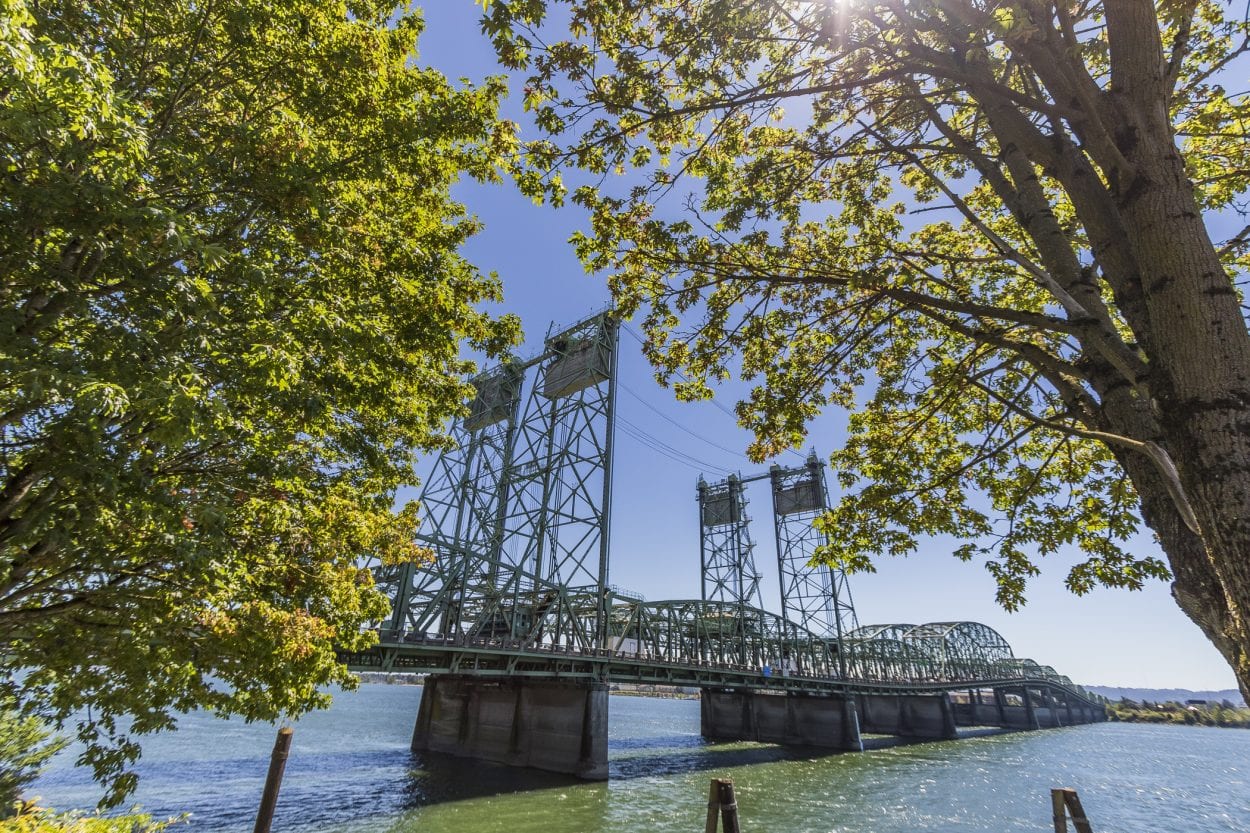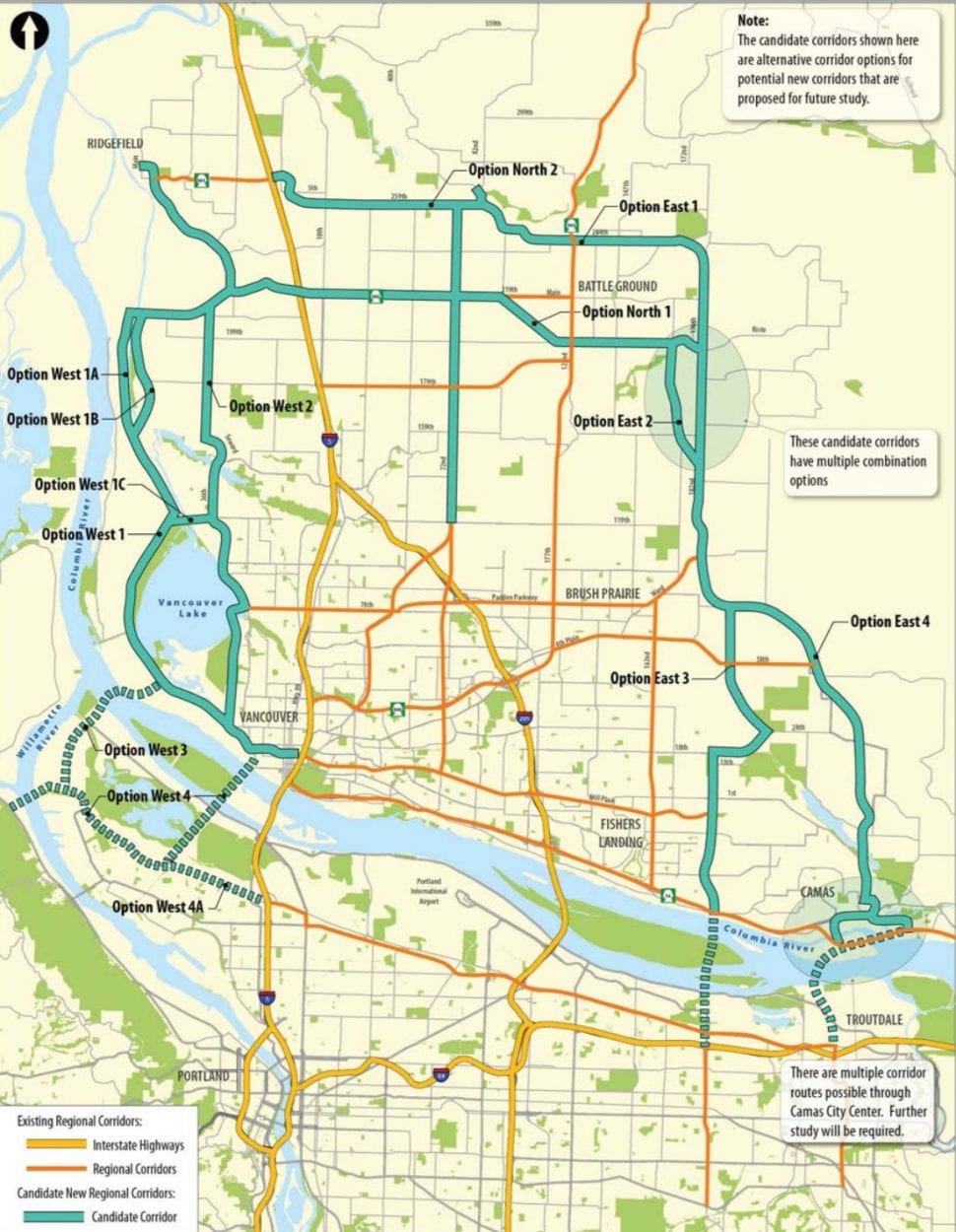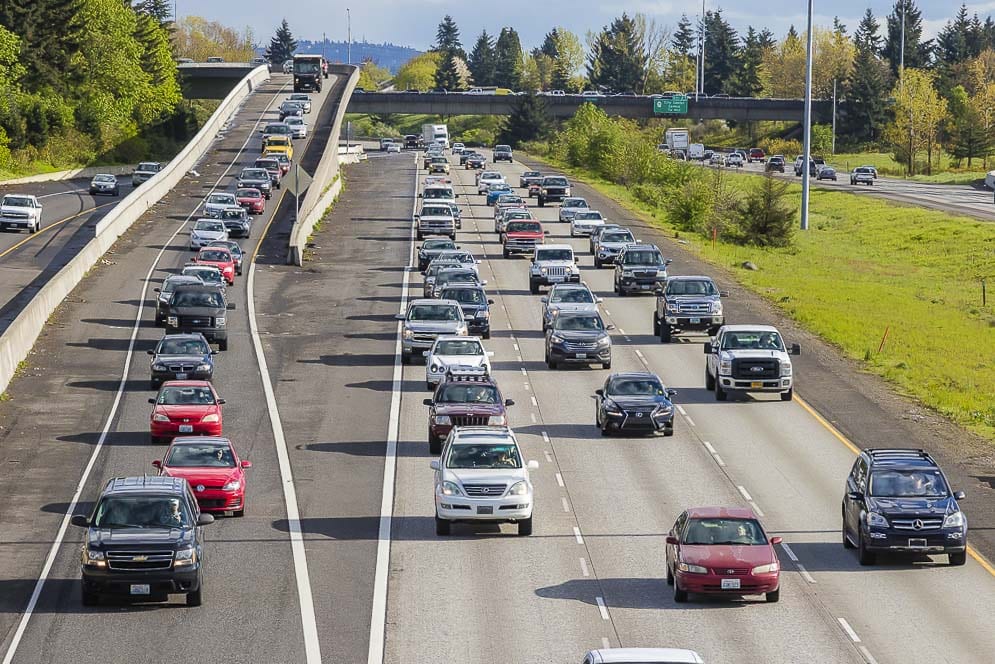The study, which took two years to complete, largely fell by the wayside during the recession
VANCOUVER — It has been more than 11 years since the Southwest Washington Regional Transportation Council (RTC) completed a Transportation Corridors Visioning Study.
The two-year study was labeled a “50,000-foot” look at where transportation needs were headed in Clark County, and outlined some possible locations for new major corridors.

“The study actually raised more questions than perhaps was anticipated when the study was initiated,” said Lynda Davis, a senior transportation planner with RTC, at the group’s August meeting this past Tuesday.
The study was conducted largely based on comments by then-Battle Ground Mayor John Idsinga, who wanted to look into a major traffic corridor between his city and Camas, both of which were experiencing explosive growth at the time. The study aimed to look beyond the 20-year planning cycle of the Growth Management Plan, as well as the federal and state-mandated Regional Transportation Plans.
Rather than looking at a specific timeframe, the study largely looked at what kind of transportation corridors Clark County might need when its population hits one million people, or four million for the entire Portland-Vancouver metro area.
“To put these growth assumptions in context. the demographics are similar to those of the whole Puget Sound metropolitan region,” said Davis, “including King, Snohomish, Pierce, and Kitsap counties in the mid 2000s.”
Davis says the objective of the study was to look at a scenario in which growth in Clark County continued unabated.
“In the study, we were looking at accommodating more than twice today’s population and employment in the Clark County region,” Davis said. “The land use scenario assumed in the Corridor Visioning Study was for continued growth patterns similar to the growth patterns accommodated in the 20-year Comprehensive Growth Management Plans, with expansion of urban growth areas.”

Davis noted it’s necessary to understand that the study didn’t delve into a cost-benefit analysis of any potential new corridors, or how many daily trips each corridor might serve. The goal, she said, was simply to facilitate further conversation by the cities within Clark County, as well as the county itself.
“It must be emphasized that the study did not evaluate the feasibility of connections into Oregon, and it did not provide a need or benefit cost assessment,” Davis told the RTC Board. “And the review did not engage affected Washington agency partners or Oregon stakeholders, as this was viewed as a first step and as an exploratory study only.”
What dominated the discussion at the RTC meeting, then, was the question of why a second step was never taken.
“Why didn’t Oregon participate?” asked Clark County District 4 Councilor Gary Medvigy. “And then the second question is, why didn’t RTC, at some point, pass a resolution to kick off some of this planning both north and south of the river?”
Davis responded that the primary question of the study was to examine potential new corridors in Clark County, “and it then became a secondary sort of question, ‘well, would any of the new corridors within Clark County be able to be extended across the river?’”
While there were no Oregon representatives on the steering committee, Davis said they were kept up to date on the findings.
“Basically, the next steps in the process would be to look at scenario planning,” said Davis, “and really turn focus to land use to sort of ask the citizens of Clark County ‘well, what do you want your community to look like in the future? Do you want growth to extend well beyond the current urban growth areas?’”
According to Davis the RTC isn’t designed to guide discussions over land use, and depended on cities to take up that discussion. But, she said, the recession hit hard just as the study was being completed.
“A lot of the local jurisdictions lost a lot of their planning staff at that time,” said Davis. “So unfortunately, the next step was not taken.”

“When we start talking about bridges and corridors, everybody turns into an engineer or cartographer, or an expert planner,” said Battle Ground Mayor Mike Dalesandro. “Unfortunately, this isn’t something that you can just flip a switch and create a corridor tomorrow, or multiple corridors. But I think we should continue to have the discussion.”
Dalesandro said, at this point, local jurisdictions need to be involved to talk about where major corridors could go, what that would mean for land use planning, and how any major projects would be financed.
Washougal City Councilor Paul Greenlee agreed, saying Washington state law makes it difficult to simply build a major transportation corridor without long-range land use planning.
“What [RTC] can do is convene a planning process, but we don’t actually have the authority to make and to set down a plan,” said Greenlee. “That exists with the county and the cities and towns.”
As for Oregon’s part in the planning process, Greenlee said it’s important to note that at least three-quarters of any new Columbia River crossing would have its footprint in Oregon, meaning they would likely need to start the discussion.
Greenlee added that, in his opinion, talking about new corridors into Oregon would be a waste of time.
“Frankly, as an economic developer in Clark County, I’m not sure that it’s not in our interest for it to be difficult to cross the river,” Greenlee added. “That actually tends to push economic development here, not over there.”
“So, that was painful to listen to,” responded Medvigy, “but it really explains why there’s been no further steps in the last 10 years. We hear from our constituents every day, they’re all saying the same thing: ‘Why aren’t you doing anything?’”
Medvigy said he would like to see new studies on what traffic congestion in Clark County actually costs, both in terms of the economy, and the health of the population, to compare with what the expected cost of new corridors might be.
“We need to take the next step forward,” he said. “If we can’t bring Oregon along, then I think this body can go directly to the federal transportation highway system, you know, all those agencies. We have a navigable river that the country cares about. I-5 is a Strategic National Defense corridor. And so maybe the national government would join with us.”
Vancouver Mayor Anne McEnerny-Ogle, who serves as chair of the RTC, said she would speak with the mayors of other Clark County cities at their monthly meeting to see if they would like to begin work on a land use study for transportation corridors.
Rep. Vicki Kraft of Southwest Washington’s 17th District also responded to Greenlee, saying she believes Oregon could be brought to the table for discussions over a third river crossing.
“We can’t kid ourselves,” she said, “we have to have more crossings. For our commuters, for our freight, our economy. So I believe we do have the power to provide leadership, engage them in this conversation, and now is exactly the time to do it.”
Kraft said there have been conversations in the Oregon Legislature about a Northwest Passage across the Columbia River west of I-5, though nothing active since 2017.
“I think that insisting that we need a corridor without also insisting that we look at our land use is
failing to take into account the full picture,” cautioned Clark County District 1 Councilor Temple Lentz, noting that the county will be tackling an update to their Comprehensive Growth Management Plan in the near future. “That may be a very good time to take a look at the framework and the underpinnings of all of the assumptions. And … talk about a community process to discover what the community wants, and how the different jurisdictions want to work together to achieve this vision and these goals.”
“I would be really interested to see where you and your council sit on this,” responded Vancouver Mayor Pro Tem Bart Hansen. “But, to take it back to another level, where does your district sit on this? The people that actually live in your district, how do they feel about something like this coming through there of that magnitude?”
Hansen said he has strong doubts that a new corridor across the Columbia River will happen while he’s still in his current position, but added he definitely would like to continue the conversation about new corridors within Clark County.
In public comments ahead of the presentation on the 2008 study, a number of people spoke in favor of pursuing a third crossing.
John Ley, of Camas, a vocal critic of plans to prioritize a new I-5 Bridge ahead of a third crossing, said RTC Board members have ignored their own long-range planning on the matter.
“Your 2008 visioning study highlighted the need for two new transportation corridors and bridges across the Columbia River, one west of I-5 and the other East of I-205,” said Ley. “Your goal after today’s review of this 2008 study must be to not only plan for both third and fourth bridges and transportation quarters, but actually begin seeking funding and taking action.”
Ley says even replacing the I-5 bridge won’t save time for Clark County commuters heading to Portland, due to the pinch-point at the Rose Quarter that Oregon’s Department of Transportation currently has no plans to address.
“Widening the mouth of the funnel does nothing when you only have two lanes at the Rose Quarter as your restriction,” said Ley, holding up an actual funnel by way of demonstration. “Portland doesn’t want more cars and trucks in the downtown area. It makes sense to build bypasses allowing cars and trucks to go around the congestion.”
To read more of the RTC report on the 2008 Transportation Corridor Visioning Study, click here.
To view a slideshow of the presentation from Monday’s RTC Board meeting, click here.
To watch video of the entire RTC Board meeting from August 6, click here.




